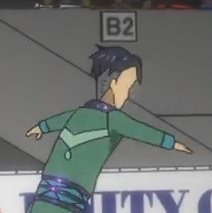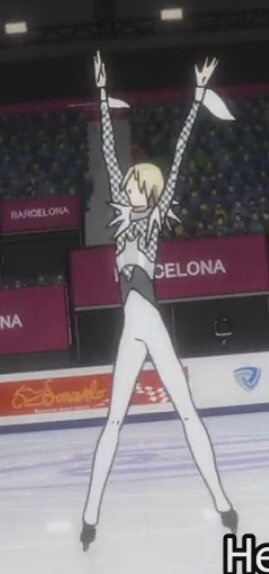autumnrainchaos:sammysguardianangel:izumooo:Are you really gonna tell me yoi deserves best animation
autumnrainchaos:sammysguardianangel:izumooo:Are you really gonna tell me yoi deserves best animation of the year on crunchyroll bc it had like 4 scenes with hyper shiny lips when there’s a twitter with hundreds of screenshots like this(( before I start this rant, I want you all to know that I appreciate this as a joke but I need to get this off my chest ))Okay you know what *cracks knuckles*I AM SICK OF THIS ARGUMENT THAT SO AND SO ANIMATION IS BAD BECAUSE OF THESE KIND OF SCREEN CAPS.I’m an animation student. I’m not great at it yet, but I know the principals of it well. These are usually either smears or squash and stretch. (combined with distance from the ‘camera’/viewer obscuring details)Smears:Smears are single frames in an animation that create the sensation of extremely fast movement. And guess what, IT HAPPENS IRL TOO. It’s called motion blur. Our eyes are essentially cameras for our brain. The rods and cones in our eyes fire off to take the picture, then take a couple mili-seconds (or whatever the scientifically accurate amount of time is) to reset. That’s why strobe lights produce the effect they do. That’s why movies - animated or not - work in frames. And smears are just replicating motion blurs. Do they look weird as hell- and in all honesty can be just as funny, yes, but they work. Because they are a single frame, which usually occurs within a 12 or 24 frame range over the course of a second. (( also, Yuri on Ice’s animation is significantly different in terms of frame rate from most Japanese animation, which uses less frames than western animation ))Squash and Stretch:Squash and Stretch is the idea that you can create visual impact by distorting a character/pose slightly - or drastically depending on the style - to create a sense of weight. Now, Yuri on Ice is obviously not ‘rubber house’ animation, so the squash and stretch is more subtle.Fun fact: a perfectly rotoscoped movie will actually have really terrible animation. No one in animation is quite sure why it is, but if you perfectly copy movie frames, certain things like walks just don’t come out right and fall directly into the uncanny valley.When used subtly, squash and stretch is what brings life into realistic animations. It can convey how difficult something is - squashing down to build up power before a jump, impact - a stretch before hitting something tricks our eyes into thinking the hit was stronger, and all things relating to weight. And as shown above, it’s crucial to getting realistic jaw and mouth movements.So that’s why this frame argument is BS.As to why Yuuri on Ice IS such incredible animation? ICE SKATING IS HARD AS SHIT TO GET RIGHT.Let’s start with just the opening sequence. Ice skating takes a very different set of weight shifts to look correct, and most of the time, animation has relied on contextual clues to make sure the viewer gets that the characters are on ice. Now, we can see their skates in the opening, but there’s hardly ever a rink behind them until the final episode.Compare this, contextuallyNow, these do have very different styles of animation, but what I want you to look at is the way that Yurio comes into frame versus the way Linus moves across the bottom. Linus moves like a cutout just sliding along the backgroung, right? Where as Yurio, whose skates we can’t see mind you, is clearly pushing into the motion with his whole body, and then needs to use his whole body to transfer into the next motion. Even if you were just kind of puttering around on skates, anyone who has skated knows that you need some push to get moving.Yuri on Ice manages to give us the feelings of weight and movement behind the characters that tell us, without snow or ice, or even really skates, that the movement is ice skating.Let’s talk about frame rate too, shall we?Japanese animation - specifically anime - usually runs at 12 frames per second. To get technical, you could call is 24 frames per second on 2s, meaning each image is held for two frames. And a good portion of the off ice animation is still done at this frame rate. This is by no means a bad thing, as Japanese animators have a distinctive style of squash and stretch that can add the feeling of smoothness and flow missing due to the frame rate.Yuri on Ice runs at 24 frames on ones for ice skating scenes, if I’m not mistaken. But it does run at a higher frame rate regardless. That’s why this……looks so much more fluid than this.AND THAT’S FUCKING HARD TO DO. That’s why episode 6, where each new skater got to show off nearly a full routine, is weaker on animation quality. Because they had to draw so much more to fill the same amount of time, and deadlines are a thing.I could rant forever about this…Also, anyone who gets butt hurt about how few frames there are to complete spins A) has never had to animate something that technically difficult, B) doesn’t realize that the less frames between two poses, the faster the movement is, and ice skaters spin FAST.TLDR: Single frames look weird because of animation equivalents of motion blur and needing to exaggerate subtleties for them to read properly. And Yuri on Ice tackled a huge frame rate related challenge in the same time span as other animation teams not facing that challenge.YOU CANNOT JUDGE AN ANIMATION BY LUCKY TIMES SCREENCAPS OF SMEARSI love you -- source link
#animation

